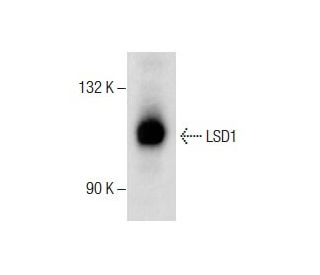


PC-3 nuclear extract: sc-2152
- supplied in four vials, each containing 250 µg nuclear extract in 50 µl buffer
- provided in 20 mM HEPES (pH 7.9), 20% v/v glycerol, 0.1 M KCI, 0.2 mM EDTA, 0.5 mM PMSF and 0.5 mM DTT
- human nuclear extract; prostate adenocarcinoma cells
- suitable for use in Gel Shift and Western Blotting assays
- Extracts should be stored at -70°C and repeated freezing and thawing should be avoided.
- prepared by the method of Dignam et al., (1983) Nucleic Acids Res. 11: 1475
QUICK LINKS
SEE ALSO...
The PC-3 nuclear extract is derived from the PC-3 cell line, a human prostate adenocarcinoma cell line used primarily for cancer biology research. This nuclear extract contains a wide array of nuclear proteins, including transcription factors, nuclear receptors, and other regulatory proteins that play pivotal roles in gene expression and cellular signaling pathways. In research, PC-3 nuclear extracts are extensively utilized to study the regulation of gene expression related to cell cycle control, apoptosis, and cellular differentiation in prostate cancer cells. A particular focus has been on the activity of transcription factors like NF-κB and STAT3, which are known to be active in these extracts and are crucial for understanding cellular proliferation and survival mechanisms. Additionally, these extracts have facilitated studies on the impact of chromatin remodeling and epigenetic modifications in cancer progression. The PC-3 nuclear extract provides a rich resource for probing the nuclear mechanisms underlying prostate cancer biology, offering significant insights into the fundamental processes of gene regulation. This makes it an essential tool in the field of cellular and molecular biology research.
PC-3 nuclear extract References:
- Mitogen-activated protein kinase pathway is involved in alpha6 integrin gene expression in androgen-independent prostate cancer cells: role of proximal Sp1 consensus sequence. | Onishi, T., et al. 2001. Biochim Biophys Acta. 1538: 218-27. PMID: 11336792
- Prostate cancer expression of runt-domain transcription factor Runx2, a key regulator of osteoblast differentiation and function. | Brubaker, KD., et al. 2003. Prostate. 56: 13-22. PMID: 12746842
- USF2 is connected to GAAAATATGATA element and associates with androgen receptor-dependent transcriptional regulation in prostate. | Kivinen, A., et al. 2004. Prostate. 59: 190-202. PMID: 15042619
- 15-Lipoxygenase-2 gene regulation by its product 15-(S)-hydroxyeicosatetraenoic acid through a negative feedback mechanism that involves peroxisome proliferator-activated receptor gamma. | Subbarayan, V., et al. 2006. Oncogene. 25: 6015-25. PMID: 16682954
- Multiple androgen response elements cooperate in androgen regulated activity of the type 1 neutral endopeptidase promoter. | Zheng, R., et al. 2006. Mol Cell Endocrinol. 259: 10-21. PMID: 16949732
- Epigenetic regulation of phosphatidylinositol 3,4,5-triphosphate-dependent Rac exchanger 1 gene expression in prostate cancer cells. | Wong, CY., et al. 2011. J Biol Chem. 286: 25813-22. PMID: 21636851
- DNA unwinding by ASCC3 helicase is coupled to ALKBH3-dependent DNA alkylation repair and cancer cell proliferation. | Dango, S., et al. 2011. Mol Cell. 44: 373-84. PMID: 22055184
- Targeting amino acid transport in metastatic castration-resistant prostate cancer: effects on cell cycle, cell growth, and tumor development. | Wang, Q., et al. 2013. J Natl Cancer Inst. 105: 1463-73. PMID: 24052624
- Destruction of DNA-Binding Proteins by Programmable Oligonucleotide PROTAC (O′PROTAC): Effective Targeting of LEF1 and ERG. | Shao, J., et al. 2021. Adv Sci (Weinh). 8: e2102555. PMID: 34397171
Ordering Information
| Product Name | Catalog # | UNIT | Price | Qty | FAVORITES | |
PC-3 nuclear extract | sc-2152 | 250 µg/0.05 ml | $160.00 |
